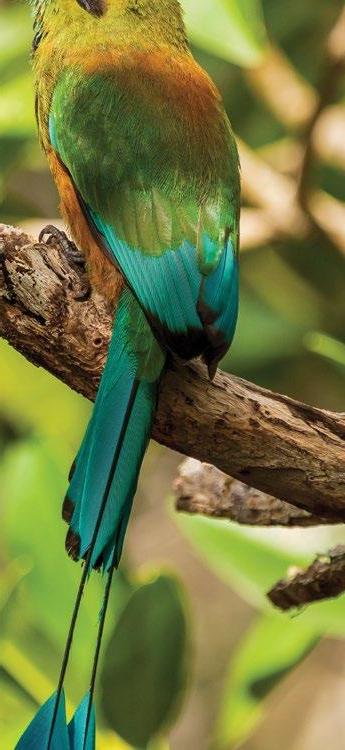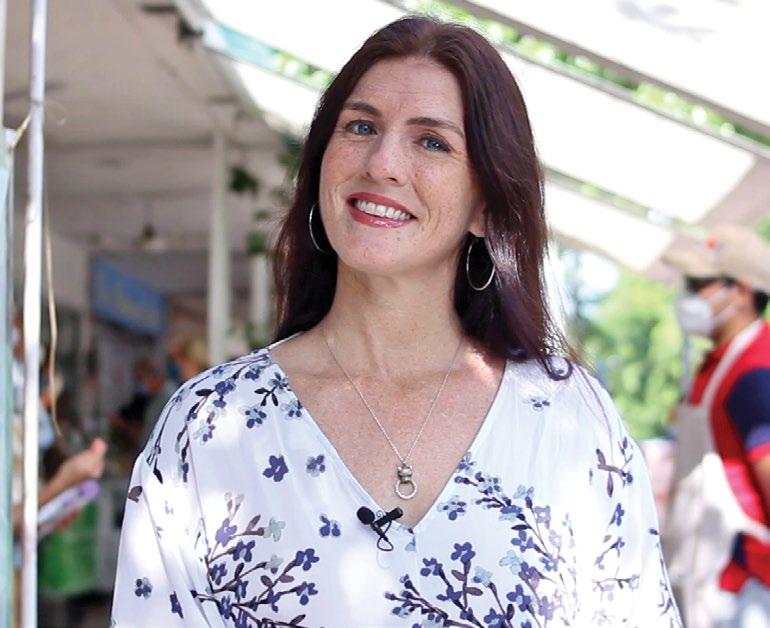
9 minute read
Explorando | Exploring
El pájaro Toh, el ave de las tierras sagradas mayas
POR AGUSTÍN GONZAGA
Advertisement
México cuenta con una gran diversidad de especies de aves, se estima que hay unas 1400 especies, es decir el 20% de la avifauna del mundo habita esta región; nuestro país ocupa el doceavo lugar a nivel mundial y el primero en Norteamérica. Un importante porcentaje se localiza en la Península de Yucatán y dentro de ellas se ubica el pájaro Toh cuyo nombre científico es Eumomota superciliosa, es una especie nativa y representativa del territorio yucateco que además de prestar servicios ambientales, funciona como indicadora de la salud de la zona de selva en donde se encuentra.

Esta ave tiene una característica peculiar al poseer colores llamativos, los cuales destacan el verde y azul en diferentes tonalidades. Igualmente, tiene una cola desnuda que termina con la forma de una pequeña raqueta emplumada, que mueve como si fuera un péndulo, por lo que también se le conoce como el “pájaro relojero”. Como dato curioso, su nombre es onomatopéyico porque el sonido que hace es “mot mot”. Su canto es una manera de delimitar su territorio, pues de esa forma anuncia ser el dueño de éste porque de ahí se alimenta.
Su alimentación es variada, consiste en insectos, frutos de diversos árboles y hasta de pequeños reptiles, lo que le permite permanecer en un mismo sitio por mucho tiempo. Es considerada un ave de la tierra maya, pues vive cerca de los territorios que los mayas consideraban sagrados, tales como los cenotes.
El pájaro Toh juega un papel importantísimo en el ecosistema al ser un regulador, el hecho de encontrarse con uno, significa que esa selva es sana y como servicio ambiental, es dispersor de semillas a través de las heces fecales que distribuye en su vuelo.
Editorial completa en explore.mx
Fotografías: @MIKEDIAZPHOTO / @GOGONZAFILMS

The Toh bird, the Bird from the Sacred Maya Lands
Mexico has a great variety of birds. It’s believed there are 1,400 species in total. This means that 20% of the all of the world’s bird species lives here. In fact, our country occupies the twelfth place worldwide and the first in North America for avian species. An important number is located in the Yucatán Peninsula. One of them is the Toh bird, or the turquoise-browed motmot (Eumomota superciliosa), a native species, that is representative of the region. The Toh bird, among other things, is a good indicator of where scrub forests become tropical forest zones.
The Toh bird has a peculiar feature because their attractive colors, which highlight the green and blue at different tones. At the same time, it’s featherless tail ends with the shape of a little feathered racket that moves like it be a pendulum; it’s often called “the watchmaker bird.”
One curious fact is that the bird’s name in English is onomatopoeic; its call does sound like “mot mot.” The song serves to delimit his territory, well announcing that the bird calling lives in the area from where he feeds. The bird’s diet is diverse, consisting of insects, diverse fruits from the trees, and even small reptiles. It’s territorial and remains in the same habitat for a long time. The Toh bird is considered a bird from the Maya region and it makes its home in places the Maya considered sacred, such as the cenotes—natural freshwater sinkholes. The Toh bird is very important in the ecosystem because is an environmental regulator. This means that when you sight a Toh bird, you know the surrounding areas are healthy; one of the vital services it provides is seed dispersal through its feces.
More information at: explore.mx
Slow Food Market

POR STEPHANIE CARMON ¡Hola! Soy Stephanie Carmon, creadora del blog MID CityBeat, donde hablo, escribo y comparto muchas historias acerca los lugares que visito, así como cosas qué hacer y mostrando quienes hacen cosas geniales en Mérida. En esta ocasión junto con Explore Yucatán, queremos mostrarles uno de mis sitios favoritos para pasar un sábado en la mañana: The Slow Food Market.
Tengo viviendo 10 años en la ciudad y siempre voy a Slow Food Market, un mercado de productores que ha tenido la misma ubicación desde hace 11 años en la Calle Reforma entre la Avenida Cupules y Avenida Colón, pero realmente existe desde hace 13 años. Este lugar es muy especial porque es un mercado de la tierra, en todo el mundo solamente hay 69 mercados de este tipo, México tiene 2 y uno está en Mérida.
Slow Food Market Yucatán es sumamente especial, sus vendedores respetan y cumplen estrictamente los estándares de calidad, ya que en sus productos no pueden usar químicos. La mercancía que ofrecen y producidos por ellos están totalmente libres de sustancias dañinas, así que vas a obtener alimentos completamente limpios. Entre los muchísimos productos que venden son hierbas, hortalizas, miel y carnes, aunque éste último no es necesariamente orgánico, está libre de químicos al estar hechos en casa.

Además, encontrarás frutas, vainilla y tres vendedores de pan de diferentes tipos. Realmente hay una gran variedad de puestos. Dentro de la misma plaza que ocupa Slow Food Market, también hay cafés y restaurantes, después de realizar tus compras puedes comer o tomarte un cafecito. Básicamente, estás en un lugar donde te sentirás saludable y podrás adquirir cosas 100% naturales y de excelente calidad. ¡Me encanta el mercado! Soy un cliente frecuente y se los recomiendo ampliamente. ¡No puedes perdértelo!
¡Sigue a Stephanie Carmon en sus redes sociales! MID CityBeat @midcitybeat www. midcitybeat.com
EDITORIAL COMPLETA EN WWW.EXPLORE.MX



Hello! I’m Stephanie Carmon, founder of the MID CityBeat blog, where I speak, write, and share many stories about the places I visit— as well as things to do and who’s doing great things in town. This time, together with Explore Yucatán, we want to show you one of my favorite places to spend a Saturday morning: The Slow Food Market.
Visiting the Slow Food Market BY STEPHANIE CARMON
I have lived in the city for a decade and I always go to Slow Food Market, a farmers’ market, that although 13 years old, has been located at the same location for 11 years right on Reforma Avenue between Cúpules and Colón avenues. This place is very special because there are only 69 Slow Food markets in the world; Mexico has two, including this one in Mérida.
The Slow Food Market Yucatán is very special. The vendors respect and strictly comply with standards for quality; no preservatives are used in their products. They make or grow the goods they offer which are totally free of artificial substances, so you are going to get completely wholesome food.
Among the many products they sell are herbs, vegetables, honey, and meats. Although the meat may not necessarily grass fed, it is free of additives and are prepared or cured at home. In addition, you will find fruits, vanilla, and three bakers providing various kinds of breads. There are really a good number of various products. In addition, there are also cafes and restaurants, after doing your shopping you can have lunch or have a coffee.
In essence, you are in a place where you will feel healthy and you will be able to buy 100% natural and excellent quality things. I love the market! I am a frequent customer and I highly recommend it. If you’re in Mérida on a Saturday, you can’t miss it!
Follow Stephanie Carmon on MID CityBeat @midcitybeat www. midcitybeat.com

Una de las edificaciones más icónicas y representativas de la ciudad y que llaman la atención de los transeúntes es “El Pinar”. Ubicada en la Calle 60 por la avenida Colón del Centro Histórico y a una cuadra de Paseo de Montejo, fue construida en 1915 según en su página web oficial www.elpinar. com.mx en pleno auge henequenero en Yucatán. Sin embargo, otras fuentes mencionan que se construyó en 1905. Ha tenido varios dueños, le perteneció a Humberto Peón, luego la compró Alberto Bulnes Guedea, la reformó para venderla a José Trinidad Molina Castellanos. Los años no le han cobrado factura a el pinar, sigue intacta en su arquitectura. One of the most iconic and representative buildings of the city and that attract the attention of passersby is “El Pinar”. Located on Calle 60 by Avenida Colón in the Historic Center and one block from Paseo de Montejo, it was built in 1915 according to its official website www.elpinar.com.mx during the henequen boom in Yucatán. However, other sources mention that it was built in 1905. It has had several owners, it belonged to Humberto Peón, then Alberto Bulnes Guedea bought it, reformed it to sell it to José Trinidad Molina Castellanos. The years have not taken their toll on the pine forest, it is still intact in its architecture. ¿Sabías qué? En marzo ocurre el fenómeno astronómico del equinoccio en tierras yucatecas. En el Castillo de Chichén Itzá se puede observar el descenso de la serpiente emplumada (Kukulkán) en las escaleras; en el Templo de las 7 Muñecas ubicado Dzibilchaltún, los rayos solares se alinean en la entrada y salida de dicha construcción, creando así un fenómeno impresionante de luz y sombra. Did you know? In March, the astronomical phenomenon of the equinox occurs in Yucatecan lands. In the Chichén Itzá Castle you can see the descent of the feathered serpent (Kukulkán) on the stairs; In the Temple of the 7 Dolls located in Dzibilchaltún, the solar rays are aligned at the entrance and exit of said construction, thus creating an impressive phenomenon of light and shadow.


¿Sabías qué? Desde el 21 de marzo de 1977 se celebra el “Día del Trovador” en Yucatán. De igual manera, en la misma fecha, pero desde el 2013, también se conmemora el “Día de la guayabera”. Con estas dos celebraciones, el Estado recibe con los brazos abiertos a la primavera. Did you know? Since March 21, 1977, the “Troubadour Day” has been celebrated in Yucatán. Similarly, on the same date, but since 2013, the "Day of the guayabera" is also commemorated. With these two celebrations, the State welcomes spring with open arms.









